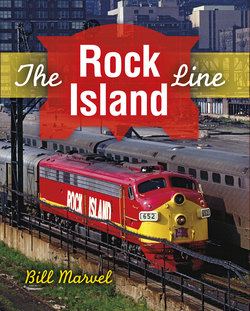Читать книгу The Rock Island Line - Bill Marvel - Страница 10
Rock Makes Tracks
ОглавлениеWith Rock Island rails advancing across Illinois, in February 1853, the Iowa legislature, meeting in Iowa City, granted three of the road’s original founders—Antoine LeClaire, Ebenezer Cook, and A. C. Fulton—a charter to build another railroad. This new enterprise would reach from the banks of the Mississippi at Davenport across the state to Council Bluffs, and it would be called, logically enough, the Mississippi & Missouri Railroad. Capitalization was set at $6 million.
From the start, the M&M was created to continue the westward march of the Chicago & Rock Island. Besides LeClair, Cook, and Fulton, organizers included Rock Island’s president, John B. Jervis; Farnam, who was the road’s chief engineer and contractor; and Durant. Rock Island’s treasurer, A. C. Flagg, became M&M’s treasurer.
Eastbound at Colona, Illinois, GP7 No. 4517 gleams in Rock Island’s “new image” blue-and-white scheme created by John Ingram. On June 8, 1975, the former No. 1274 is just three weeks out of the Capital Rebuild Program at Silvis shops. Bill Marvel
William Walcott, a Farnam associate, was placed in charge of acquiring right-of-way and looking into possible branch lines. His committee soon recommended that M&M build a branch south from Davenport to Muscatine and northeastward to Cedar Rapids and the Minnesota border. In June 1853, the charter was duly amended. On September 1, Antoine LeClair turned the first spadeful of earth in Davenport, and three days later a survey party led by Grenville Dodge began working westward. The surveyors arrived in Council Bluffs on November 22. Actual construction would not begin for a year and a half.
Across the river, however, track crews were busy. On February 22, 1854, citizens of Rock Island had something besides George Washington’s birthday to celebrate. The first train from Chicago rolled up to the “passenger house” at 5 p.m., announced by church bells, cannon fire, and huzzahs. At a party that evening, N. B. Buford, a longtime Rock Island resident and member of the railroad’s board, raised his glass to toast the “espousal . . . of the Mississippi River and the Atlantic Ocean.” Less than 25 years had passed, he noted, since the first locomotive had run on American rails and less than two since rails had reached Chicago. Then citizens bundled against the cold to watch fireworks displays on both sides of the river. A larger celebration of the new railroad would wait for warmer weather.
On the morning of June 5, two special trains packed with Rock Island stockholders, investors, journalists, politicians, and distinguished guests (among them former President Millard Fillmore) rolled out of Chicago for the formal opening of the 181-mile line. In the evening there was the usual grand banquet with speeches and toasts, and the next day guests boarded five chartered steamboats for two days of excursions along the river. Among their destinations was St. Paul, Minnesota, where citizens were already talking about a railroad of their own.
In August, a full year and a half before the promised date, Farnam and Sheffield officially turned over the Chicago & Rock Island to its directors. Some track still awaited ballast, and a couple stations had not been finished; however, it was already a working, profitable business. In fact, more engines and cars were needed to handle traffic. Directors voted the necessary funds and elected Henry Farnam president. Farnam’s financial associate, Joseph Sheffield, 61, wanted to devote his remaining years to philanthropy. One of his last official acts was to arrange for a first-day excursion train on the Peoria & Bureau Valley, now leased to the Rock Island. In November, he retired. To take his place, Farnam chose the energetic and ambitious Thomas Durant.
Beyond the end of track rolled the waters of the Mississippi, and plans were already in place to cross them. A group of the road’s directors had obtained a charter from the legislature for the Railroad Bridge Company. Farnam was president and chief engineer, and its bonds were guaranteed by the Chicago & Rock Island and the Mississippi & Missouri railroads. The new company would construct the Illinois side of the bridge to mid-channel; M&M would build the Iowa side, with the ever-helpful Antoine LeClair donating the needed land. Construction would occur in three segments: a short span across The Slough, right-of-way across Rock Island, and the main section. The wooden Howe truss superstructure would march across the river to Davenport on six granite piers, the largest anchoring a pivoting center span on the Illinois side.
The eastbound local behind GP7 No. 4517 makes its leisurely way along the banks of the Illinois River at Peru on June 8, 1975. The river, the railroad, and the nearby Illinois and Michigan Canal once made this a thriving port. Bill Marvel
